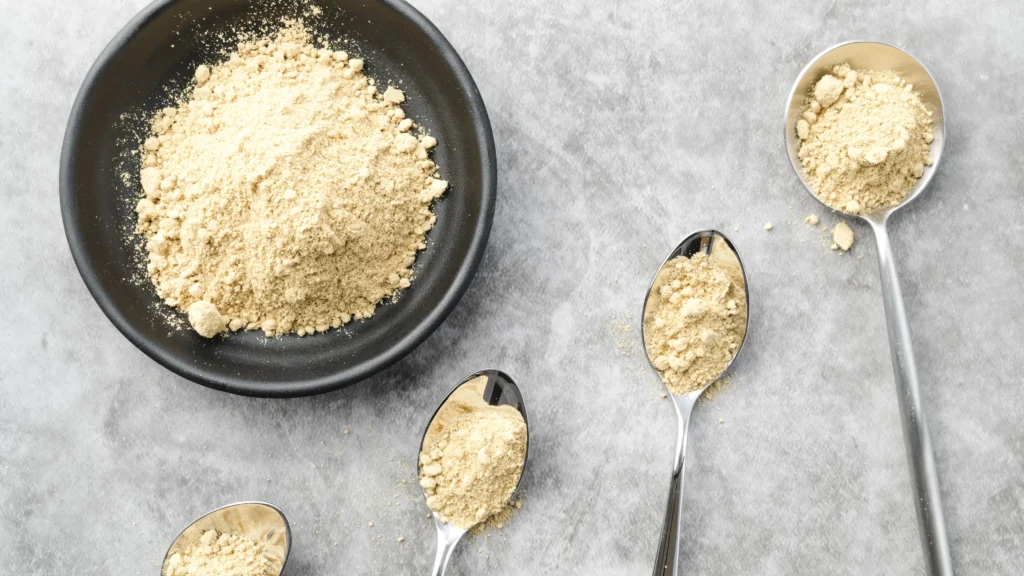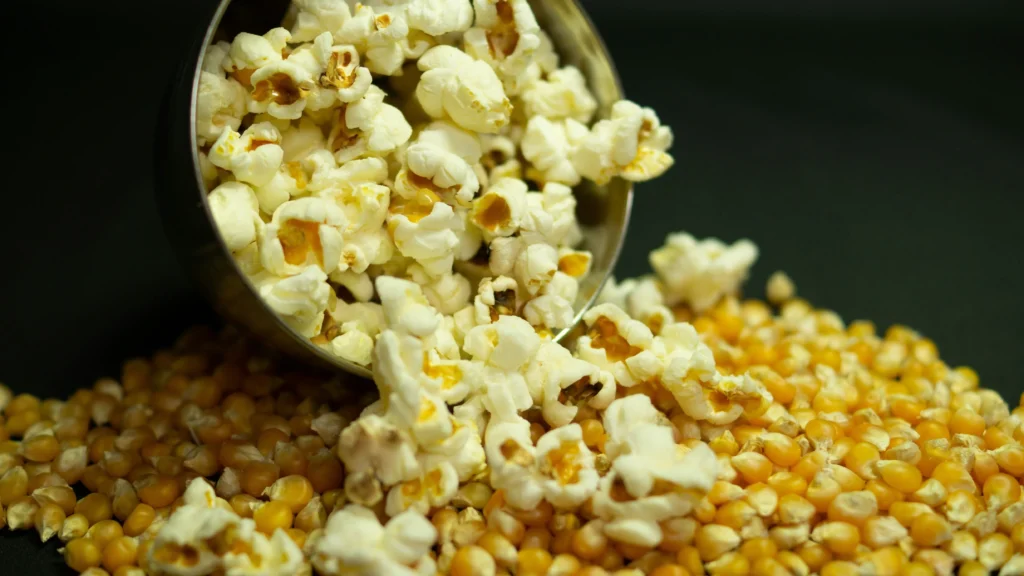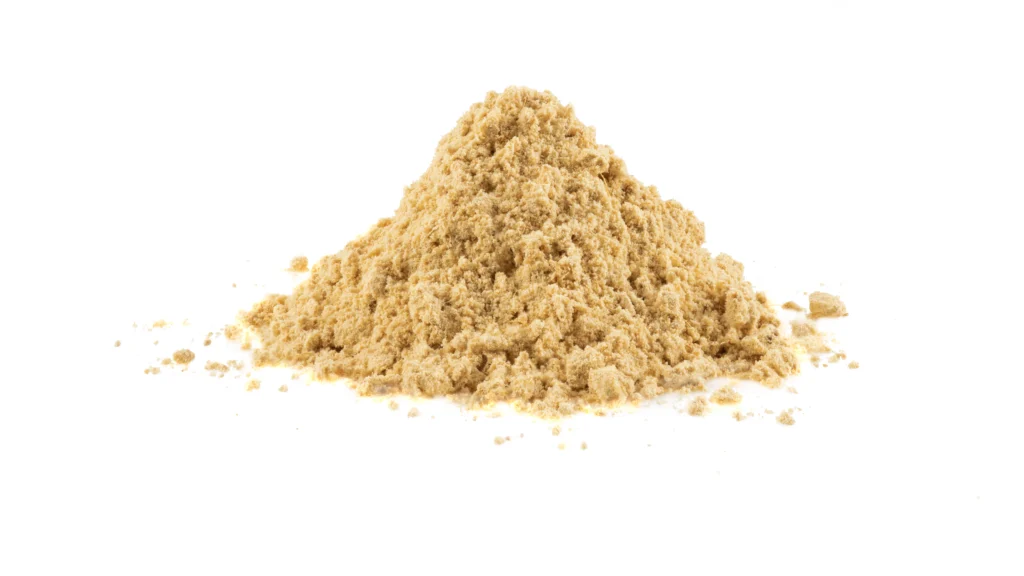Defining Nutritional Yeast: Not Your Average Yeast
Imagine sprinkling something that looks like fish food onto your popcorn and suddenly experiencing a rich, cheesy flavor without any dairy at all. That’s the magic of nutritional yeast, affectionately called “nooch” by its devoted fans.
Nutritional yeast is deactivated Saccharomyces cerevisiae, a strain of yeast that has been grown specifically for its nutritional content, then harvested, washed, and heated to render it inactive—meaning it cannot be used for baking or brewing. Unlike active yeasts that make bread rise or ferment beer, nutritional yeast is a food product valued for its flavor and nutrients.
Most commonly found as yellow flakes or powder, nutritional yeast has a distinctive cheesy, nutty, and umami flavor profile that makes it a favorite among those looking to add savory depth to their meals. The texture is light and crispy when dry, dissolving easily when mixed into liquids.
Show Image
It’s important to distinguish nutritional yeast from its relatives:
- Baker’s yeast: Active, used to leaven bread
- Brewer’s yeast: Used in beer production, typically has a bitter taste
- Nutritional yeast: Deactivated, used as a food product for flavor and nutrition
Nutritional Powerhouse: Nutrition Facts Explained
Fortified vs. Unfortified Nutritional Yeast (Key Difference!)
The single most important thing to understand about nutritional yeast is the distinction between fortified and unfortified varieties.
Fortified nutritional yeast has vitamins added during processing, especially B vitamins like vitamin B12 (cobalamin). This fortification process substantially enhances its nutritional profile and makes it particularly valuable for those on plant-based diets.
Unfortified nutritional yeast contains only the nutrients that naturally develop during the growth process. While still nutritious, it lacks the added B vitamins—most critically B12—that many people seek from this food.
This distinction is crucial, especially for vegans and vegetarians who might be relying on nutritional yeast as a B12 source. Always read the label to determine whether the product you’re purchasing is fortified or not. If you’re counting on it for B12, verify that “vitamin B12” or “cobalamin” is listed in the ingredients or nutrition facts.
Macronutrients: Protein-Packed Goodness
Nutritional yeast stands out in the plant world as a complete protein source, meaning it contains all nine essential amino acids humans need to obtain from food. Here’s the macronutrient breakdown for a typical 2-tablespoon (16g) serving:
- Protein: 8-9g (complete protein with all essential amino acids)
- Fiber: 4-5g (supports digestive health)
- Carbohydrates: 5-7g (primarily fiber)
- Fat: 0.5-1g (very low)
- Calories: 45-60
This impressive protein-to-calorie ratio makes it a valuable addition to plant-based diets.
Key Vitamins (Focus on Fortified Varieties)
The vitamin content of nutritional yeast varies significantly between fortified and unfortified varieties. Here’s what you’ll typically find in fortified nutritional yeast (2 tablespoon serving):
- Vitamin B1 (Thiamine): 640% DV (Daily Value)
- Vitamin B2 (Riboflavin): 570% DV
- Vitamin B3 (Niacin): 280% DV
- Vitamin B6 (Pyridoxine): 480% DV
- Vitamin B9 (Folate): 60% DV
- Vitamin B12 (Cobalamin): 130% DV
Unfortified nutritional yeast naturally contains B vitamins (except B12) but in significantly lower amounts.
Minerals: Essential Trace Elements
Nutritional yeast also provides important minerals, including
- Zinc: Supports immune function and wound healing
- Selenium: Acts as an antioxidant
- Manganese: Assists with metabolism and bone formation
- Iron: Essential for oxygen transport and energy production
- Potassium: Regulates fluid balance and muscle contractions
Potential Health Benefits of Nutritional Yeast (Evidence-Based)
Nutritional yeast isn’t just flavorful—it offers several evidence-based health benefits:
Rich B Vitamin Source
The high B vitamin content in fortified nutritional yeast supports:
- Energy production:B vitamins aid in the process of converting food into energy.
- Brain function: Supports cognitive health and neurotransmitter synthesis
- Cell metabolism: Essential for proper cell function throughout the body
For vegans and vegetarians, fortified it can be one of the few reliable non-animal sources of vitamin B12, which is critical for preventing anemia and maintaining nerve health.

Complete Plant-Based Protein
With approximately 8g of protein per 2 tablespoons, nutritional yeast provides all nine essential amino acids, making it a complete protein—a rare quality in plant foods for people on plant-based diets, this makes it very beneficial.
Immune System Support
Nutritional yeast contains beta-glucans, complex carbohydrates that have been shown to have immune-modulating effects. Research published in the Journal of Applied Research has found that beta-glucans may help activate immune cells and enhance their function.
Antioxidant Properties
Nutritional yeast contains powerful antioxidants like glutathione and selenomethionine that help neutralize harmful free radicals in the body. A study in the Journal of Medicinal Food found that yeast-derived selenium compounds demonstrated significant antioxidant activity.
Cholesterol Management
The beta-glucans in nutritional yeast may help lower cholesterol levels. A review published in the International Journal of Molecular Sciences indicated that beta-glucans can bind to cholesterol in the digestive tract, preventing its absorption and potentially reducing LDL (bad) cholesterol levels.
Risks, Side Effects, and Considerations
While nutritional yeast offers impressive benefits, it’s not suitable for everyone. Consider these important factors:
Yeast Sensitivity or Allergy
Individuals with yeast allergies or sensitivities should avoid nutritional yeast. While it’s inactive, it still contains yeast proteins that can trigger allergic reactions in sensitive individuals.
Potential Migraine Trigger
Nutritional yeast contains tyramine, a compound that may trigger migraines in susceptible individuals. If you have a history of migraines, especially those triggered by fermented foods, you might want to introduce nutritional yeast cautiously.
Digestive Adjustments
The high fiber content in nutritional yeast can cause temporary digestive discomfort, including gas and bloating, if introduced too quickly into the diet. Start with small amounts (½-1 teaspoon) and gradually increase as your digestive system adjusts.
MSG Misconceptions
Nutritional yeast contains naturally occurring glutamates, which give it its umami flavor. These are not the same as added monosodium glutamate (MSG). Glutamates are found naturally in many foods, including tomatoes and cheese. If you have a specific sensitivity to glutamates, you might experience similar reactions to nutritional yeast, but it does not contain added MSG.
Medical Conditions Requiring Caution
- Inflammatory Bowel Disease: Some individuals with Crohn’s disease or ulcerative colitis may find that yeast products exacerbate symptoms.
- Gout: Nutritional yeast contains purines, which can increase uric acid levels. Those with gout may need to limit consumption.
Medication Interactions
Those taking Monoamine Oxidase Inhibitors (MAOIs), a class of antidepressants, should consult with their healthcare provider before consuming nutritional yeast due to its tyramine content.
How to Use Nutritional Yeast: Flavor Without the Dairy!
The versatility of nutritional yeast is perhaps its most appealing quality. Here are some delicious ways to incorporate it into your meals:
Sprinkle It On
- Popcorn: Create a cheesy, savory snack by sprinkling nutritional yeast on freshly popped corn
- Roasted vegetables: Add depth to roasted broccoli, cauliflower, or potatoes
- Salads: Use as a dairy-free alternative to Parmesan
- Pasta: Top any pasta dish for an instant flavor boost
- Avocado toast: Elevate your breakfast with a savory sprinkle
Mix It In
- Vegan cheese sauce: Blend with cashews, plant milk, and seasonings for a creamy sauce
- Soups and stews: Stir in for added umami and nutrition
- Scrambled tofu: Create an eggy flavor in tofu scrambles
- Salad dressings: Whisk into vinaigrettes for depth
- Mashed potatoes: Mix in for a cheesy flavor without dairy
Simple Vegan “Cheesy” Popcorn Recipe

- Pop 1/4 cup popcorn kernels using your preferred method
- Lightly spray or drizzle with olive oil
- Sprinkle with 2-3 tablespoons nutritional yeast
- Add 1/4 teaspoon garlic powder and a pinch of salt
- Toss until evenly coated
- Enjoy immediately!
Expert Input: Insights from a Registered Dietitian
“Nutritional yeast is one of my top recommendations for clients transitioning to plant-based diets. The fortified variety provides essential B12 that’s otherwise difficult to obtain without animal products. Beyond the nutritional benefits, it helps new vegans adapt to life without cheese by providing that savory, umami flavor they might be missing.” – Dr. Sarah Johnson, RDN
“I always remind clients to start slowly with nutritional yeast if they’re not used to high-fiber foods. Begin with a teaspoon and gradually work up to the standard serving size. This minimizes any potential digestive discomfort while allowing you to enjoy all the nutritional benefits.” – Dr. Sarah Johnson, RDN
Buying and Storing Nutritional Yeast
Where to Find It
Nutritional yeast has moved beyond specialty health food stores and can now be found in many mainstream supermarkets:
- Health food stores: Usually available in bulk bins (most economical) or packaged
- Grocery store chains: Look in the health food section, spice aisle, or baking section
- Online retailers: Convenient option with various brands available
What to Look For
- Fortification: Check the nutrition facts panel for B12 if that’s important to you
- Ingredients: Ideally, just yeast or yeast with added nutrients
- Expiration date: For maximum freshness and nutrient potency
- Organic certification: If avoiding potential pesticide residues is a priority
Storage Tips
- Store in a cool, dark place in an airtight container
- Refrigeration can extend shelf life, especially in humid climates
- Properly stored, nutritional yeast typically lasts 1-2 years
- If it develops an off smell or taste, it’s time to replace it

Frequently Asked Questions
Is nutritional yeast the same as brewer’s yeast?
No. While both come from the same species (Saccharomyces cerevisiae), they’re produced differently and have distinct flavors and nutritional profiles. Brewer’s yeast is a byproduct of beer brewing and tends to taste bitter, while nutritional yeast is grown specifically for consumption and has a cheesy, nutty flavor.
Is nutritional yeast gluten-free?
Nutritional yeast is naturally gluten-free. However, some brands may be processed in facilities that also handle gluten-containing products. If you have celiac disease or severe gluten sensitivity, look for brands specifically labeled “gluten-free” to avoid potential cross-contamination.
Can nutritional yeast make yeast infections worse?
No. Nutritional yeast is the species Saccharomyces cerevisiae, which is completely different from Candida albicans, the fungus responsible for most yeast infections. Additionally, nutritional yeast is deactivated (dead), so it cannot grow or reproduce in your body.
How much nutritional yeast should I eat per day?
A typical serving size is 1-2 tablespoons (4-8 grams). There’s no official upper limit, but as with any food, moderation is key. If you’re new to nutritional yeast, start with smaller amounts (1/2-1 teaspoon) and gradually increase to assess your tolerance.
Does nutritional yeast taste good?
Taste is subjective, but most people describe nutritional yeast as having a pleasant cheesy, nutty, or savory flavor. Its umami quality enhances many dishes, particularly those that might traditionally use cheese. Some people love it immediately, while others acquire a taste for it over time.
Conclusion: Why Nutritional Yeast Deserves a Place in Your Pantry
Nutritional yeast is far more than just a dairy-free cheese alternative—it’s a nutritional powerhouse that can boost the protein, fiber, and vitamin content of nearly any savory dish. With its impressive B vitamin profile (especially in fortified varieties), complete protein content, and versatile culinary applications, it’s no wonder nutritional yeast has moved from obscure health food to mainstream kitchen staple.
Whether you’re vegan, vegetarian, dairy-free, or simply nutrition-conscious, nutritional yeast offers an easy way to enhance both the flavor and nutritional value of your meals. Just remember to check whether your nutritional yeast is fortified if you’re counting on it for vitamin B12, and as with any new food, introduce it gradually if you have a sensitive digestive system.
